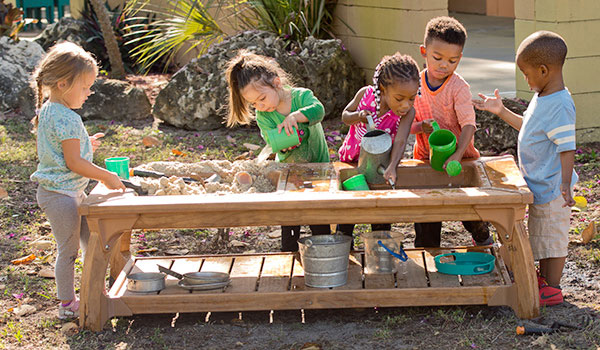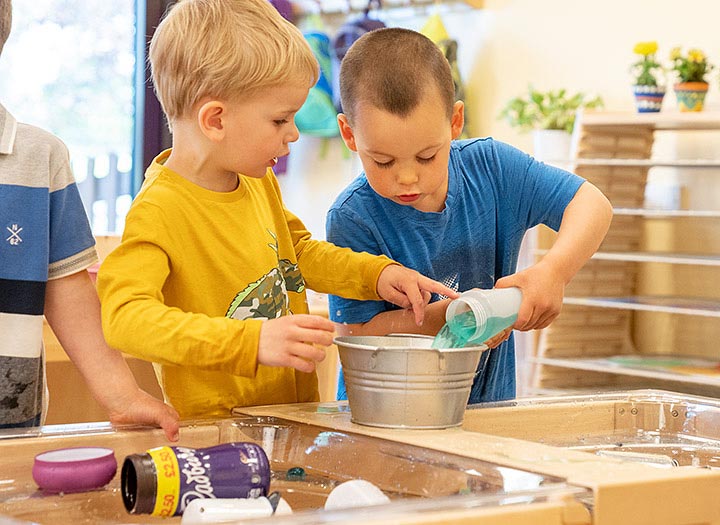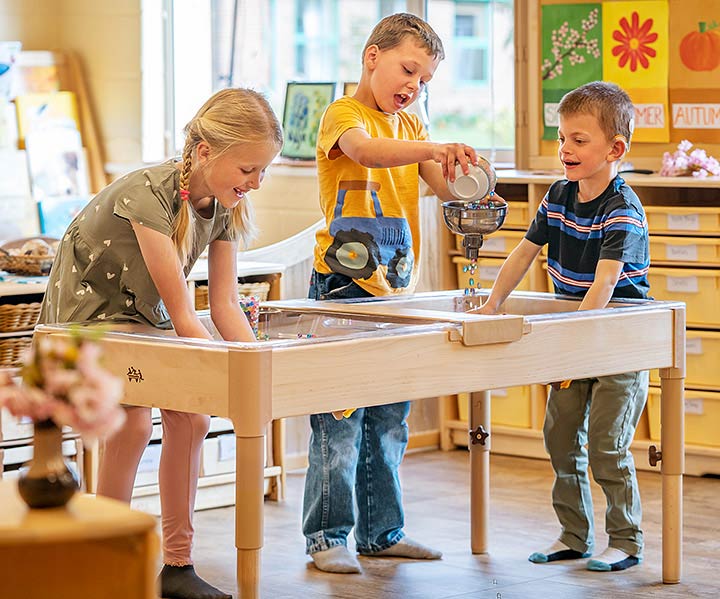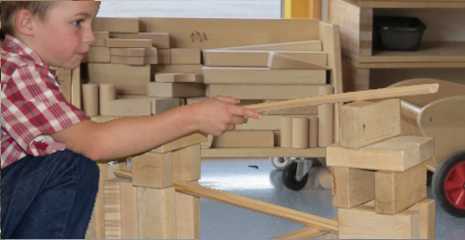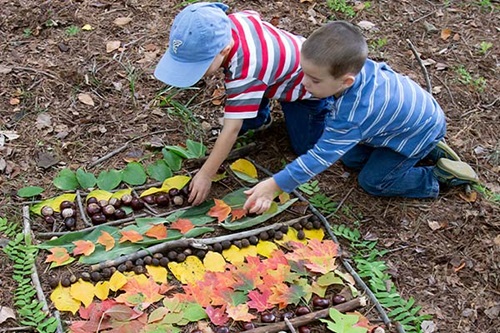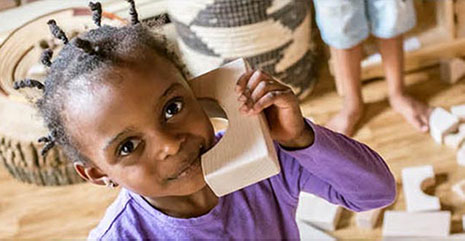Making the most of water play
| June 2012Puddles, spray bottles, garden sprinklers, and wading pools bring back gleeful memories of childhood. Even now, driving home after a rain, I secretly anticipate splashing down the little lane that the children and I have nicknamed the “puddle road.” It is simply fun to play in water.
Early childhood educators have traditionally capitalised on the child’s natural affinity for water play by including it as a centre in the classroom and by featuring it outdoors in warm weather. However, with the recent emphasis on academics typified by workbooks and ditto sheets, water tables are becoming an endangered species, and in too many programmes children spend much less time outdoors than they used to. Perhaps it is time to look a little closer at the nature of water play and the potential it holds for engaging young children in meaningful learning.
Water is one of the basic raw materials for purposeful play. Just like sand, clay, and blocks, children can use water without being constrained by the one, right way to use it. Unlike many of the commercially produced, flashy playthings tempting us between Saturday-morning cartoons, water is a plaything that fosters curiosity, imagination, and experimentation – and it is free.
In the early childhood setting or outdoors, a water centre can be the catalyst for building concepts, developing language, and promoting social skills. Water play is developmentally appropriate regardless of the child’s physical condition, age, language, gender, culture, or exceptionality (Bredeikamp 1987). Water is intriguing. It seems to draw children to explore its structure and properties. Because water is naturally fascinating, the thoughtful teacher can structure the environment and materials in the water centre to make the most of water play.
What can children learn from water play?
Thoughtfully prepared, a water centre, whether indoors or out, can foster cognitive development, teach mathematics and science concepts, enhance physical skills, promote social learning and cooperative effort, and enrich language experiences.
Cognitive development
Modern cognitive psychology holds that children have a drive to make sense of their world (Piaget 1954). Given ample opportunities to manipulate materials in the environment, children build mental maps or frameworks through which concepts are developed. Furthermore, children assimilate new information into existing mental maps to refine and extend the concepts they have built (Wadsworth 1989).
When new information does not fit into an existing framework, the structure must be adjusted to accommodate the new input. This lack of fit is very important for teachers because, for us, it means that puzzling, novel situations can promote learning. For example, a child playing with a variety of objects in water might come to the mistaken conclusion that heavy objects sink and light objects float. The child has built incomplete mental maps for the concepts, “objects that float” and “objects that sink.” If that child comes across an object that is heavy and also floats, such as a log, she will experience disequilibrium – cognitive dissonance – clashing beliefs. Because a heavy object that floats will not fit in the child’s mental framework for floating and sinking, the child will be challenged to adjust her thinking framework.
Without the time and opportunity for lots of exploration, a child formulates fewer meaningful concepts. While water play promotes problem-solving and thinking skills in general, it is particularly well suited to the development of concepts in mathematics and science.
Learning mathematics
Depending on which materials the teacher selects to incorporate into the water centre, specific mathematical concepts can be built. The following list contains a sample of mathematical concepts that can be built through water play. You and the children will think of even more.
|
empty/ full |
many/ few |
before/ after |
|
thick/ thin |
more/ less |
same/ different |
|
heavy/ light |
shallow/ deep |
greater/ less than |
|
sets |
classification |
rational counting |
|
liquid measure |
ordinal counting |
linear measure |
Learning science
Water play leads children to ask questions (Chaille & Britain 1991). What does it do? How can I change it? Curiosity leads to experimentation, which provokes even more curiosity and more questions to challenge and intrigue. Children engage in both inductive and deductive thinking as they explore the properties of water. Inductive thinking uses facts and concepts to build a generalized conclusion. Deductive thinking is inferring the particular facts and concepts that support a general principle. Concepts can be built about force, energy, properties of liquids, states of matter, displacement, surface tension, pollution, solutions, and ecology.
Learning physical skills
Physical skills are developed through use. A water-play centre promotes use of both large and small muscles as well as the skills needed to coordinate eye and hand movements.
Children use large muscles as they lift buckets and wield big sponges while they fill, empty, and clean up the water area. Short-handled mops for cleaning up drips and splashes also enhance large-muscle development.
Eye-hand coordination is practiced as children retrieve objects with tongs, aquarium nets, scoops, and fingers. Hand whisks, basting bulbs, and egg beaters require coordination and are fun to use.
Small muscles get a workout as plastic tubes are fitted to funnels, medicine droppers are manipulated, water is poured from container to container, squeeze bottles are explored, and sponges are wrung dry.
Learning social skills
Water play may be solitary, parallel, associative, or even cooperative play with a group goal. The form of play depends on the felt needs of the children involved at the time. Whatever the form of play, children have many opportunities to find out what happens if sharing of materials and ideas takes place. Even solitary play requires consideration for the needs of others.
Learning language
When children play, they use and learn language naturally. Words such as sieve, funnel, surface, whip, flow, slot and strain enrich the young child’s vocabulary and allow him to express himself more explicitly. Positional words (beside, above, next to) and words that express relationships (larger, smaller, last) grow naturally out of water-play experiences. Children learning English as a second language particularly benefit from the language interaction that flows when children work either together or side by side.
In addition to the benefits of oral language development, water play can be extended to meaningful written language experiences. As children make and check their own predictions, they can be encouraged to record them. In this way children learn that print can function to help us remember or to convey information. Print is also useful in labelling objects or telling the story of a sequence of steps.
How can I set up a water-play centre?
Indoors or outdoors, a water-play centre can be as simple or elaborate as budgets permit. Commercially made tables are available for water only or for water and sand combined. Covers are usually optional. Most water tables come with drains for ease in emptying; but, because the plugs do not always maintain their seal after repeated use, some teachers prefer to empty the water by hand.
Carefully select materials to enhance water play with thought given to their potential for learning and of course, for safety. Equipment that has sharp edges or that might break or rust should never be used. Straws are potentially dangerous because very young children have a tendency to suck rather than blow into them.
Equipment that is frequently changed or modified renews interest and provokes divergent thinking. The list of items suitable for adding to water play includes common objects from school, home, and nature. You and the children will think of many more possibilities.
Practical concerns must be addressed as you plan the centre. Placement near a sink or tap is most desirable. A large sheet of heavy plastic will protect floor coverings.
Children will need plastic smocks or aprons to keep clothes dry. They can be purchased or easily made from oil-cloth or discarded plastic tablecloths.
Make cleaning up part of the learning experience. Children enjoy using sponges, rags, and short-handled mops to do “grown-up” work.
What is the role of the teacher?
To make the most of water play the teacher needs to be an enabler.
- Structure the centre so children have interesting, challenging, and puzzling materials to stimulate their active play.
- Sometimes, post open-ended questions, engage in active listening, model the use of new vocabulary, encourage prediction, and thoughtfully observe what children do.
- From time to time, debrief the children – give them the opportunity to tell others what they did and learned at play.
- Occasionally help a few children evaluate their efforts and plan for what they can do tomorrow.
The teacher’s role also involves communicating to parents the value of developmentally appropriate play (Taylor 1991). When parents ask “Do you teach them anything?” tell them about the marvellous things their children are learning at your water-play centre. Invite them to visit and observe for themselves the joy and satisfaction children exude as they learn about their world firsthand.
Water, perhaps our most abundant natural resource, should not be overlooked as a precious resource for learning in the early childhood classroom and in the early childhood out-door-play area. Water is not just for washing, and it is not just for ducks. Water is for children to enjoy and learn from!
25 ideas for promoting discovery learning in water play
- Fill the water table with ice cubes, and provide shakers of salt and lengths of string.
- Suspend a funnel low, over the water table.
- Punch a row of holes from the bottom to the top of a 2-litre soda bottle.
- Attach funnels to each end of a length of flexible plastic tubing.
- Make it fruit day – provide a whole orange, lemon, lime, apple, grapefruit, coconut, mango.
- Make it vegetable day – use fresh green beans, peas, carrot, radish.
- Put salt in the water, then try to float and sink objects.
- Substitute snow for water.
- Place a large chunk of ice in the table. Provide safely goggles, rubber mallets, ice lolly sticks, and rock salt.
- Provide lengths of plastic pipe, whole and also in sections cut in half lengthwise, to use as canals and ramps for rolling marbles, small toy cars, of blocks. Use the piping dry, then wet, and compare results.
- Make a water lens by dropping water on newspaper that has been placed inside a zippered food-storage bag.
- Punch holes in the bottom of milk cartons to make sieves. Use a variety of sizes of cartons and vary the size of the holes.
- Give children heavy aluminium foil to shape into boats.
- Suspend a pulley just above the water tables. Thread a rope through the pulley and attach a bucket to one end of the rope.
- Offer a variety of cloth squares (canvas, oil cloth, cotton, leather, silk, nylon netting, vinyl, wool, polyester).
- Experiment with all kinds of paper (blotters, newsprint, tissue, foil, waxed, corrugated cardboard, paper towels).
- Add foam or rubber alphabet letters and small fishnets to the play centre. Name the letter you catch or catch the letters that make up your name.
- Make number soup. Ladle up foam numerals. Order them, name them, see who can ladle up the largest, the smallest.
- Experiment; with waves by making a wave machine. What do we need to do with a marble or ruler to make waves? How can we vary the pattern of the waves?
- Sprinkle pepper on the water, then add floating bar soap.
- Experiment with varying the amounts of water and air inside zippered sandwich-storage bags.
- Try making a siphon with flexible plastic tubing and a bucket.
- Predict which of a variety of seeds will float and which will not. Try out the predictions. Use nuts in shells, maple seeds, cottonwood, coconuts, buckeyes, and any others children can collect.
- Challenge children to create a boat from found objects, then move it from one end of the water to the other without using their hands.
- Challenge children to make a bridge over a portion of the water, using scrap materials.
Water play enhancers
Kindle interest and stimulate the imagination by changing water-play equipment frequently. Enhance play with objects from home, school, and nature:
|
stoppers |
soup ladle |
bulb baster |
slotted spoon |
|
sieve/strainer |
funnels |
pasta |
margarine tubs |
|
film cans |
ice lolly sticks |
plastic ruler |
cooking whisk |
|
measuring cups |
spoons |
small pitchers |
cotton reels |
|
birdseed |
cooking tongs |
sponges |
squeeze bottles |
|
fishing bobbers |
corks |
scoops |
Styrofoam meat trays |
|
packing peanuts |
rubber washers |
medicine droppers |
animal figures |
|
seeds |
aquarium nets |
wood scraps |
lids |
|
empty spice tins |
milk cartons |
golf tees |
ping-pong balls |
|
latch-hook net |
plastic people |
bar soap samples |
graduated containers |
|
marbles |
magnets |
egg beaters |
washing up liquid |
|
food colouring |
canning rings |
buttons |
foil balls |
|
leaves |
salt shaker |
thermometer |
feathers |
|
sugar shaker |
tennis ball |
golf ball |
plastic eggs |
|
toy boats |
rubber gloves |
bottle brushes |
spray bottles |
Used with permission. Copyright © 2005 by the National Association for the Education of Young Children.

